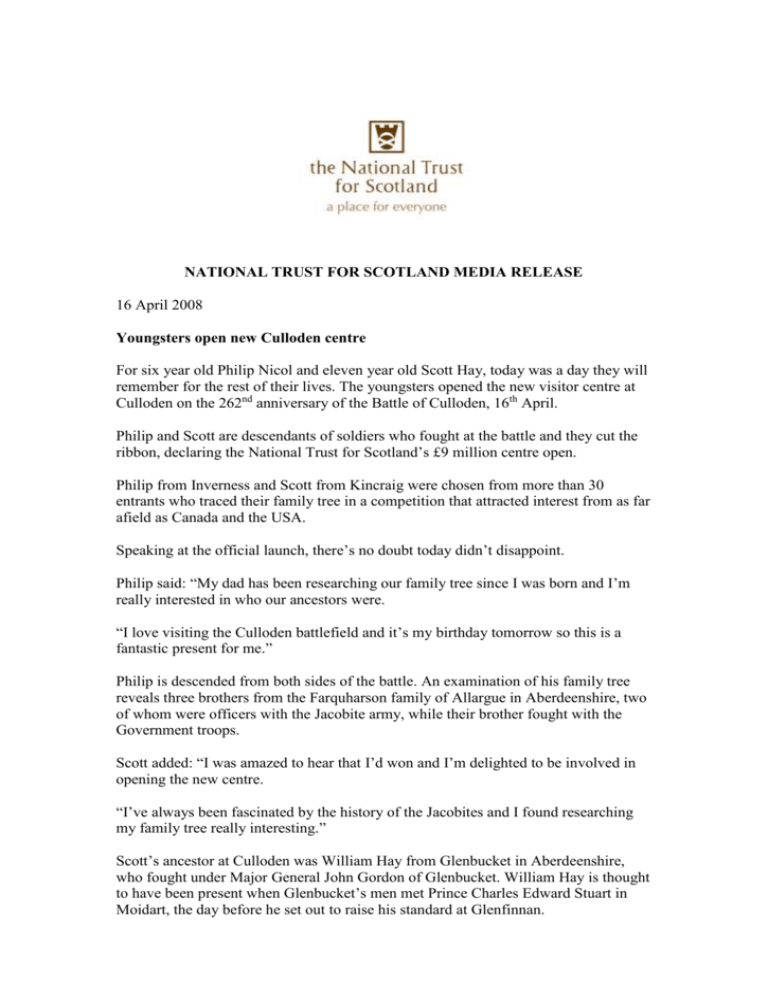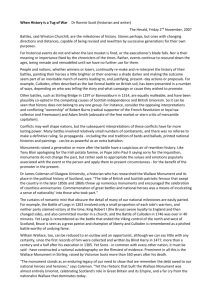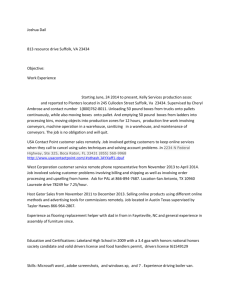the media release (DOC - 152 KB)
advertisement

NATIONAL TRUST FOR SCOTLAND MEDIA RELEASE 16 April 2008 Youngsters open new Culloden centre For six year old Philip Nicol and eleven year old Scott Hay, today was a day they will remember for the rest of their lives. The youngsters opened the new visitor centre at Culloden on the 262nd anniversary of the Battle of Culloden, 16th April. Philip and Scott are descendants of soldiers who fought at the battle and they cut the ribbon, declaring the National Trust for Scotland’s £9 million centre open. Philip from Inverness and Scott from Kincraig were chosen from more than 30 entrants who traced their family tree in a competition that attracted interest from as far afield as Canada and the USA. Speaking at the official launch, there’s no doubt today didn’t disappoint. Philip said: “My dad has been researching our family tree since I was born and I’m really interested in who our ancestors were. “I love visiting the Culloden battlefield and it’s my birthday tomorrow so this is a fantastic present for me.” Philip is descended from both sides of the battle. An examination of his family tree reveals three brothers from the Farquharson family of Allargue in Aberdeenshire, two of whom were officers with the Jacobite army, while their brother fought with the Government troops. Scott added: “I was amazed to hear that I’d won and I’m delighted to be involved in opening the new centre. “I’ve always been fascinated by the history of the Jacobites and I found researching my family tree really interesting.” Scott’s ancestor at Culloden was William Hay from Glenbucket in Aberdeenshire, who fought under Major General John Gordon of Glenbucket. William Hay is thought to have been present when Glenbucket’s men met Prince Charles Edward Stuart in Moidart, the day before he set out to raise his standard at Glenfinnan. Education, learning and young people have been put at the forefront of the Trust’s Culloden project and according to Shonaig Macpherson, Chairman of the charity, the new centre and exhibition aim to dispel many of the myths surrounding the battle and inspire youngsters like Philip and Scott to explore Scotland’s history and rich heritage. Speaking from today’s official opening she said, “Seeing the effect the new centre is having on children here today is very exciting. One of the things that became clear to us over the years was that many people still believed that Culloden was a battle between Scotland and England. “We felt it was important to take a fresh approach to telling the story, placing it in context and explaining the effects the defeat of the Jacobites had on the course of history. “Our search for young people with ancestors who fought at the battle also vividly illustrated that Scottish families were deeply divided by the conflict and it’s particularly symbolic that one of the young people helping open the centre today has ancestors who fought on both sides. “We also wanted to dispel any of the romantic ideals that often surround the story of Culloden and demonstrate just how brutal the combat really was. We’ve put the visitor at the very heart of the battle in the new immersion film which is screened across the four walls of the theatre the two sides facing each other across the room until they charge and meet in combat. ”The Culloden project is an important milestone for the Trust and is exactly the sort of work we, as a major heritage conservation and environment charity, can achieve for the benefit of the nation. This is a proud day.” The largest construction project ever undertaken by the National Trust for Scotland, the new centre, designed by Gareth Hoskins Architects and built by Morrison Construction, uses state-of-the-art technology. The Trust raised £1.8 million from a public appeal for Culloden and funding for the rest of the £9.3 million project was provided by the Scottish Government (£3.75 million), the European Regional Development Fund (£2.4 million), HIE Inverness & East Highland (£350,000) and Bòrd na Gàidhlig (£200,000). Trust Chief Executive Mark Adderley said: “This has been a very important project for the Trust and one which would not have been possible without the generous help of many. I want to thank everyone who has contributed time, money and expertise in helping us deliver a world-class facility at Culloden.” Minister for Culture Linda Fabiani said: “Scotland has a rich heritage which we must not only preserve but also understand. Culloden represents a significant time in our history and I am glad that the centre is placing a real focus on education and learning to share these events with young people. I am also pleased to see the inclusion of Gaelic in the centre and the real efforts that have been made to increase the profile of the language. “The Culloden centre will be a real cultural asset which I am sure will attract visitors from around Scotland and indeed around the world.” Dennis Malone, Chief Executive of the Highlands and Islands Partnership Programme, which administers the European Regional Development Fund in the area, said: “It’s great that the European Regional Development Fund has been able to make a significant contribution to the development of the new Culloden battlefield and visitor centre. By investing in quality, the centre will help generate economic benefits for the Highlands and Islands for many years to come. Congratulations to the National Trust for Scotland for their vision and commitment in bringing this project to fruition.” James Gibbs, area manager for the Inner Moray Firth with Highlands and Islands Enterprise (HIE), said: “I’m thrilled that HIE is among those who enabled this terrific asset to open at Culloden today. The battlefield is recognised far and wide for the part it plays in British and European history and it’s absolutely fitting that the Highlands, as a dynamic and forward-looking region, is able to interpret the site through this worldclass visitor centre.” Bòrd na Gàidhlaig Chief Executive Kenneth Murray said: “The Bòrd is pleased to see so much Gaelic being used, displayed and mentioned throughout the new centre. This is fitting in a historical sense as well as providing a sense of place in the new Scotland. “It is also an example of best practice in the use of the language; if Gaelic is to grow in the years ahead we need it to be used in practical ways such as at Culloden. “The centre is a great asset, not just to the local community but throughout the country and we look forward to seeing even more Gaelic as the centre develops in the future.” Gaelic features strongly in the new centre, with Gaelic text and music playing a prominent part in the exhibition, reflecting the large amount of Gaelic speakers who fought on both sides of the battle. The search winners and local school children were also joined at today’s official opening by Dr Tony Pollard, from BBC Television’s “Two Men in a Trench” and Dr Nick Barratt, of BBC’s “Who Do You Think You Are” who was part of the judging panel for the search for descendants to open the centre. The new interactive exhibition, designed by Ralph Appelbaum Associates, follows the progress of real-life characters through the years leading up to and after the Jacobite Rebellion and offers a unique insight into what life was like in Scotland at the time of the battle. The battlefield has also undergone careful changes, with a new footpath network with a variety of walks tailored to the amount of time available to visitors. Tours of the battlefield can be accompanied by new hand held devices which use satellite technology to provide information on what happened during the battle at strategic points. Competition winners, Philip and Scott were given life membership of the National Trust for Scotland by Chairman Shonaig Macpherson today. - ends National Trust for Scotland Press Office. Contact Sarah Cuthbert-Kerr on 07713 786 277 Editor’s Notes: The National Trust for Scotland is a conservation charity, which relies on the financial support of its members to fund its important work of caring for the natural and cultural heritage of Scotland for everyone to enjoy.







